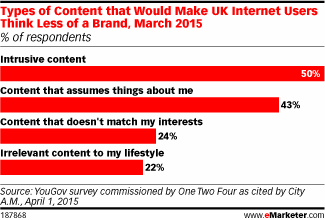Mobile Ad Revenue Share Dominated by Android; What Makes UK Consumers Think Less of a Brand
by Rebecca Muir on 7th May 2015 in News

ExchangeWire Research’s weekly roundup brings you up-to-date research findings from around the world, with additional insight provided by Rebecca Muir, ExchangeWire, head of research and analysis. In this week’s edition: for the first time, Android tops out iOS for mobile ad revenue share, what makes UK consumers think less of a brand, and Europe leads the way for smartphone and tablet traffic, as the US lags behind.
Android Dominates Mobile Advertising
Mobile advertising data from the first quarter of 2015 shows Android not just leading in traffic, but now revenue, holding a 45.8% share of total revenue generated on the platform, Opera Mediaworks discloses in its State of Mobile Advertising report.
However, iOS still dominates when it comes to making money from mobile advertising with the iPad generating more than four times its traffic volume in Q1. For mobile video ads only, iOS outperforms Android for both traffic and revenue, and video completion rates for Apple users are higher (87.1% versus 76.7%).
More highlights from the report:
- Social Networking and Games generate the most revenue. Music, Video & Media have been the traditional revenue leader on the Opera Mediaworks platform, but this quarter — for the first time — both Social Networking and Games trumped the category.
- In emerging economies, mobile advertising is in a high-growth phase. While the United States is still the top producer of impressions and revenue, there is notable year-over-year traffic growth in Asia (19%), the Americas (61%) and Africa (32%).
- Mobile video advertising is booming. In just one year, video-ad impression share increased sixfold, from 2.5% in Q1 2014 to 15% in Q1 2015; and video accounts for more than half of all global revenue generated on the platform. Some regions, however, are adopting mobile video at a faster rate. US mobile users, for instance, view more video ads than any other country; the United States’ video market share is 2.5 times its share of total user reach. Different types of advertisers, too, are showing preference for mobile video units. Movie & Television Entertainment spends the most money on video and use the most impressions; Food & Drink and Automotive brands are also using the format significantly more than other types of advertisers.
View all the quarterly insights here.
To Personalise, or not to Personalise?
We’re seeing more and more of the world’s biggest brands striving to produce personalised content based on what they know about individual consumers, and the audience segment to which they belong. Consumers may or may not be aware of this trend that is sweeping its way through ad-land, however, they do know what makes them think less of a brand.
As reported by eMarketer, a March 2015 a survey from YouGov, commissioned by digital media agency One Two Four, asked UK internet users what types of content would make them think less of a brand. The No. 1 response cited by half of the survey sample was an obvious one — intrusive content. Barge your way in front of consumers, and they’re going to begin to resent your brand. However, the second most popular response — content that assumes things about me (cited by 43% of respondents) — is a lot more insightful for brand marketers seeking to personalise ads. Unless you are 100% certain about the content you’re choosing to deliver, you risk annoying valuable consumers.
Furthermore, a November 2014 study conducted by Redshift Research for Teradata and Celebrus Technologies went some way toward supporting this notion of personalisation either not working or simply not being done. When internet users in Germany and the UK were asked why they disliked personalised messages, offers and updates, one of the most popular responses among the UK respondents was that they suggest things that are of no interest, cited by 41%.
Personalisation efforts are clearly going awry, or else they aren’t even off the ground. The problem with personalisation is that it’s too easy to get started and many marketers are racing ahead without stopping to evaluate what they’re doing. Retargeting is a great example of this, I still get shown ads for products I have already bought, despite the fact that technology exists to stop this from happening. Now, many of the forms of personalisation are much newer than retargeting and, therefore, not as refined. However, I fear marketers are not applying the same levels of rigor when it comes to personalisation as they do with other aspects of digital marketing.
Adobe Digital Index Report sets Marketing Benchmark across the Globe, Defining Best of the Best Companies
- UK top for smartphone visit rate, averaging 31% of visits to a web page
- Technology and financial service industries trail behind for mobile browsing
- Slower growth for tablet browsing — retail sector pulls ahead with 13.2% of visits from tablets
- Telecom businesses best at attracting visitors to their websites and keeping them engaged
- Average conversion rates fall across the board from 2013
Adobe has released its Adobe Digital Index EMEA Best Of The Best Benchmark to help marketers understand their results and how their performance measures up against companies that sit in the top 20%. The study, which compares the performance of companies in five countries in Europe (United Kingdom, Germany, France, Nordics, and Benelux) uses metrics such as smartphone and tablet browsing, visit rate, consumption times and conversion, to set performance benchmarks. This is the second year the research has looked at Europe, allowing comparisons to be made between performance here and in the US.
Smartphone browsing is growing faster in Europe
Compared to the US, Europe came out much faster for smartphone browsing. The UK was a clear winner, getting nearly a third (31%) of its visits to web pages from smartphones, a strong year-on-year (YOY) growth of +8.4%. The Nordics also performed well, with the average web page getting a quarter (25%) of visits from smartphones, a YOY growth of +8.7%. The only country in Europe that experienced a similar rate to the US (+5.9%) was France, which had a rate of growth at +5.6%.
The top 20% of performers, however, are pulling away much faster. In the UK, the web pages of the best performing companies are getting an incredible 52% of visits from smartphones, which is a significantly higher YOY growth of +20.9%. The best performers in Germany and the Nordics had similar figures with a YOY growth of +16.4% and +16.0% respectively.
“The study reveals that while every industry is experiencing increases in smartphone traffic, there’s a clear gap between those companies that have invested in design and functionality for a great mobile browsing experience; and this gap is getting bigger year-on-year,” said Tamara Gaffney, Principal Analyst, Adobe Digital Index. “Marketers need to look to other regions and industries to learn what’s working and what’s not; and, evidently, when it comes to handling smartphone browsing, the US has some lessons to learn from across Europe.”
Slower growth for tablet browsing
Surprisingly, tablet traffic hasn’t been following the same path as the smartphone, with adoption waning in both Europe and the US. The biggest growth was in Germany (+3.4%) and the smallest was the US (+1.3%), less than a quarter of the smartphone growth in the same region.
Whilst traffic is down overall, browsing isn’t about to disappear anytime soon. One area where tablet traffic is still high is Retail, with the average web page in Europe getting 13.6% visits from tablets. This is closely followed by Travel & Hospitality, with the average visits from tablets at 13.2%.
Financial services businesses have underdeveloped mobile browsing support
In Europe, the Financial Services industry is trailing behind Retail, Travel & Hospitality, Media & Entertainment, and Telecommunications for smartphone browsing, despite the growing trend for mobile banking. The average financial services company gets 19.8% of visits from smartphones, with the ‘best of the best’ in the industry also underperforming at 26.0%. To put this into context, the average company in the leading industry – Media & Entertainment – gets 29.1% of visits from smartphones with the ‘best of the best’ out in front with 46.1% of visits from smartphones. This suggests that the financial services sector has been more focused on its mobile app strategy and, with the added challenge of securing customer’s financial information, it has underdeveloped its mobile browsing support.
Additional Findings
- Stickiness (the percent of traffic that stays and engages with a site)In Europe, around half of website visits lasted more than one page across all countries
- -- UK, Germany, and Benelux have improved average stickiness rates versus 2013, but France and Nordics have seen rates fall
-- The stickiness rate of the ‘best of the best’ companies was up to 50% higher
-- UK has improved average stickiness rates versus 2013, to 48% for average and 72% for top performance
-- The Telecoms sector is the best at keeping people engaged, with visitors staying on websites for an average of 7.23 minutes — longer than the Retail, Travel & Hospitality, Financial Services, Technology, and even the Media & Entertainment sector
- Visit rate
- -- Performance in UK and Nordics leads all other regions in average and top performance
-- The UK has the highest visit rates with the average number of visits at 2.19 and top performers at 2.73
-- US lags behind all but France, with the average number of visits at 1.62 and top performers 1.99
-- In Europe, Telecoms and Financial Services showed the biggest improvements since 2013
-- Telecoms is the leading industry in 2014 with the number of average consumers visiting the site at 2.52 times per month
- Consumption
- -- Most countries experienced similar trends across consumption last year, measured by the amount of time spent on a website
-- The Benelux countries showed the best consumption figures, with an average of 6.53 minutes on a website
-- UK showed the lowest consumption figures, receiving the shortest at 6.07 minutes for average and 7.96 minutes for top performance
-- Germany showed the biggest difference between the leading companies (9) and the average performers (6.4)
- Conversion
- -- Conversion rates down in every country studied compared with 2013
-- France, Germany, and the Nordics saw the gap widen between the best and the rest
-- For industry conversion rates, only Technology and Telecoms made small year-on-year gains in terms of conversion rates (+0.13% and +0.15%)
-- The biggest drops in conversion rates were for Media & Entertainment, which fell from 6.9% to 1.4% and for Travel & Hospitality from 2.2% to 1.6%
AdvertiserBrandingDigital MarketingDisplayExchangeWire ResearchMartechMobilePerformanceProgrammaticTargeting









Follow ExchangeWire